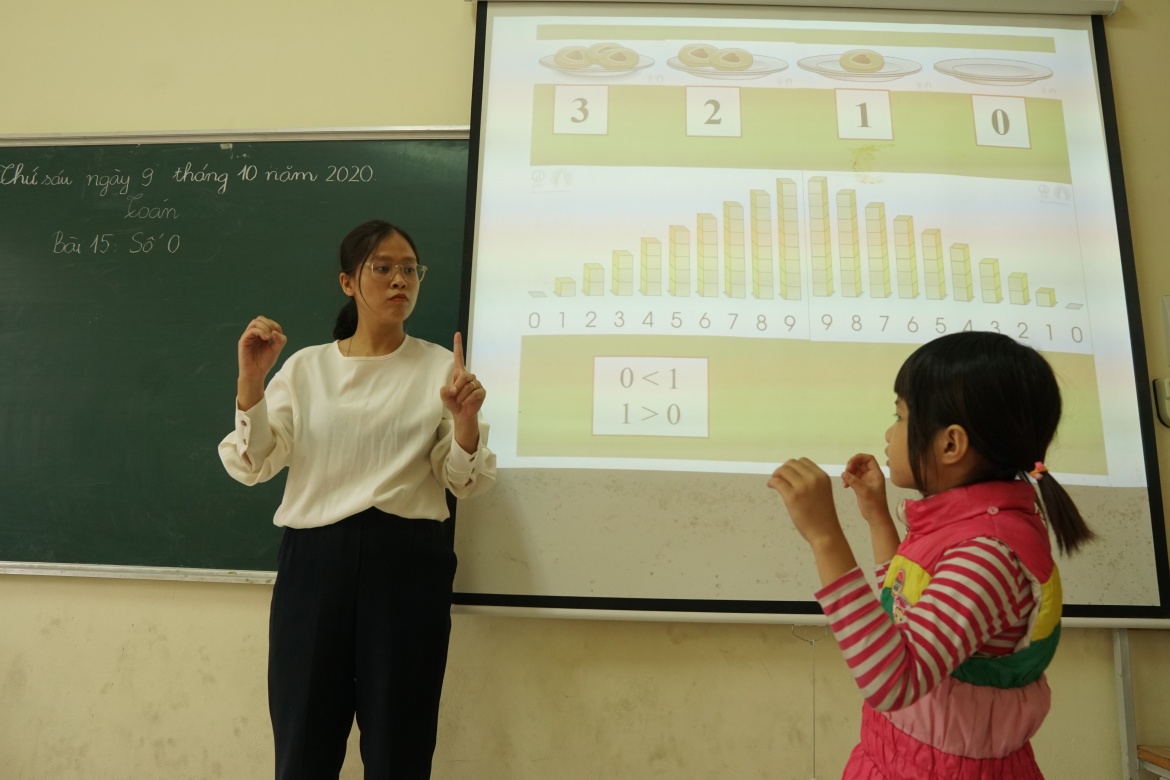Resource Type
Blog
This blog was originally posted on GPE, on August 08, 2023 by Catherine Wilczek, UNESCO Bangkok, and Qianyu Li, UNESCO Bangkok

Credit: Huynh Cuong/World Bank
With learners with disabilities remaining invisible in many education sector plans due to the absence of accurate data about them, producing and using disability-inclusive data appears crucial for making education more inclusive.
‘If people with disabilities remain invisible in data, they remain unaccounted for.’
Abu Al Ghaib, Manager of the Technical Secretariat of the United Nations Partnership on the Rights of Persons with Disabilities (UNPRPD)
As 2030 approaches, the urgency to honor the commitment of leaving no one behind, as outlined in the UN Sustainable Development Goals (SDGs), namely SDG 4 for ensuring inclusive and equitable quality education for all, and specifically SDG 4.5 on equal access to all levels of education for persons with disabilities, is growing ever more critical—particularly in regard to disability inclusion. How do we make such inclusion a reality?
The crucial initial step is to accelerate our use of disability-inclusive data.
We already know that achieving inclusive and equitable quality education for learners with disabilities requires a whole system approach—classrooms, schools and education systems well synchronized—that caters to the diverse needs of learners.
Learners with disabilities, however, remain invisible in many education sector plans, due principally to the absence of accurate data about them, as well as the barriers they face.
Ensuring the availability of data is crucial for eradicating disability-based discrimination in education and pursuing disability-inclusive initiatives, plans and policies.
Data and inclusion in education
Various global education commitments aim to ensure the rights of children with disabilities, but the lack of reliable data, especially in the Asia-Pacific region, hinders the fulfillment of this crucial obligation.
If disability data provide only a glimpse into the everyday education challenges experienced by learners with disabilities, such data nonetheless can serve as a critical starting point for developing evidence-based policies, as well as for monitoring the implementation of the Convention on the rights of persons with disabilities (CRPD, 2008).
According to UNESCAP, the Asia-Pacific region—with some 4.3 billion people, or roughly 60% of the world’s population—is home to nearly 650 million persons with disabilities, with 1 in every 6 individuals in the region living with disabilities.
UNICEF estimates that nearly 43 million children with disabilities live in East Asia and the Pacific. These children encounter some form of exclusion in all countries across the region, and access to fundamental services, like education and medical care, remains limited or unavailable to many of them—especially those living in remote areas.
The 2020 GEM Report emphasizes the prioritization of the Washington Group Short Set of Questions and the Child Functioning Module as essential data collection tools. Additionally, the GEM Report underscores the significance of administrative systems collecting data that facilitates effective planning, budgeting and delivery of inclusive education services.
The UIS Information paper outlines the significance of utilizing UIS, Education Management Information Systems (EMIS) and survey data to monitor inclusive education, especially for budgeting, resource planning, individual education plans and the guiding of policies.
The importance of data was recognized in the 2022 Global Disability Summit, which noted the need to gather and utilize better data and evidence by employing established tools to reach a comprehensive picture of the scale and nature of these challenges.
Similarly, a recommendation in the Household Survey Data on Disability and Education in GPE partner countries indicated a need for better data on disability and education for creating and implementing inclusive education policies, and for allocating resources equitably.
The findings also highlight the significance of gathering data to support evidence-based and inclusive policymaking and planning, emphasizing the need for data to effectively monitor global advancements in inclusive education.
The Jakarta Declaration also acknowledges the continuing lack of reliable data and information on the situation of persons with disabilities and aims to take action to close the gaps and strengthen capacities to track progress in disability-inclusive development at the national and subnational levels.
This is to be facilitated by producing comparable and quality data disaggregated by gender, age and disability across sectors to inform disability-inclusive policy making.

Credit: World Bank
What are we doing to close the disability inclusion gap?
When education systems do not have inclusive policies in place, disability affects access to education across all regions and income groups. Dedicated efforts are therefore required by countries to put in place disability-inclusive data systems to build a strong evidence base for inclusive education planning.
Toward this end, we organized an online workshop in June to build Member States’ capacity on disability-inclusive data and help them realize the full ambition of the 2030 Agenda. The workshop also served to foster collaboration among stakeholders in the field of disability data collection.
During the workshop, experts in the field of data and disability-inclusive education shared insights on data collection methods, while evaluating the pros and cons of various tools. The delegates reflected on the possible ways forward towards improving the cultivation and constructive employment of disability data in their countries.
This event served as a catalyst for mutual learning, collaboration and promotion of comprehensive data collection efforts in disability-inclusive education across the participating countries.
Discussions from the workshop reiterated that analysis and utilization of data are essential for developing concrete policy actions and interventions. Currently in the Asia-Pacific region, there are gaps in data collection that may result in underestimating the number of individuals with disabilities, as governments have only a limited understanding of such learners’ needs.
Failing to develop a complete view of disability-inclusive education through data can lead to ineffective policies and actions.
Therefore, including concise, reliable disability questions in surveys and censuses can provide valuable insights into how disability intersects with factors like gender. These insights can help all education stakeholders better understand the whole educational context and thus better inform effective policy design.
The time to take action is now
UNESCO Bangkok, together with its regional partners, will explore ways to scale up this work and continue supporting Member States on related areas such as disability-inclusive policy and planning, and setting measurable indicators for monitoring implementation of disability-inclusive education.
With seven short years remaining to achieve the SDG targets in the region, let us pave the way to a more disability-inclusive future by unleashing the power of disability-disaggregated data.
With collaborative efforts, we can strengthen institutions, bridge data gaps, and empower evidence-based policy making towards catalyzing a more equitable and inclusive society, and collectively ensuring that no child is left behind.
